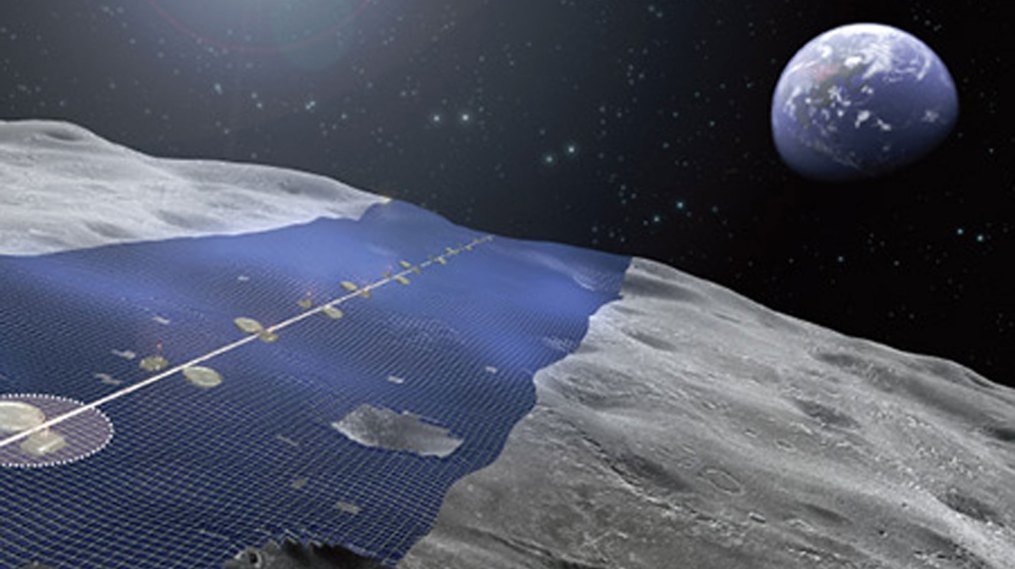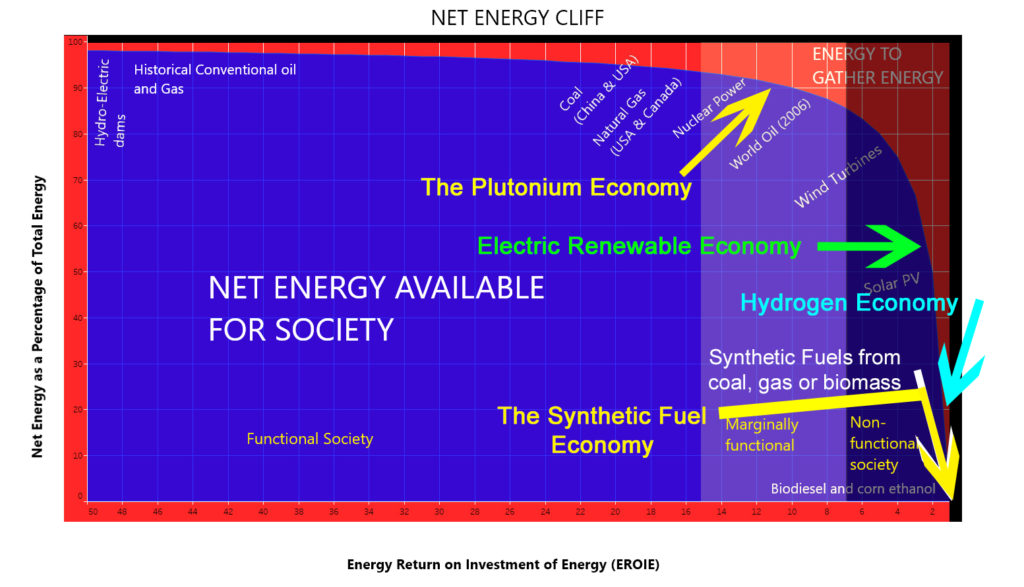The Shimizu Plan
by John Clarkson BA(Hons) Msc, Executive Producer of Perimetrfilms.com
In 2019, Valery Danko, presenter of Valery Danko Discovers Energy from Space, visited Japan. She went there to interview Professor Naoki Shinohara. They mainly discussed Earth orbit Space based Solar Power (SBSP or SSP). Yet there is another idea being worked on by the Shimizu Corporation also in Japan. This is Moon based Solar Power. It is essentially the same technology, so we will continue to call is SBSP or SSP.

Shimizu prides itself on being a large scale solution company. They specialise in architecture and engineering. Tetsiji Yoshida, head of Space Development is behind the plan.
By 2030 the humans will 17 Gigatons of oil. That is a massive amount of energy. This is about 13 Terawatts of energy. The USA in 2011 for example utilised 3.3 Terawatts of energy in total.

It is also known that energy demand, thus consumption, tends to double every decade approximately. For example, since 1950 the demand for oil has risen at a rate of 7% per annum on average. That is a huge amount, because it is exponential growth. Two becomes 4, 4 become 8, 8 becomes 16 and so on. This is what has driven the oil industry to re-visit old sites, by using fracking techniques. This is why many oil companies have exploited dangerous regions like the Gulf of Mexico. They are also now eyeing the Pole and Antarctic to meet the demand for oil.
We need a better solution than fossil fuels, not just because Climate Change, but also to reduce air and water pollution. Shimizu’s plan is to build a Solar panel Lunar Ring 6800 miles long, 12 miles wide on the moon’s surface. This would be like covering half of the USA with solar panels. This would provide 13 Terawatts to the earth. In other words it covers the need for oil based fuels. All we have to do is to utilise it.
Such a project would use far more resources than available on Earth. Instead they would mine the moon’s resources. They might also mine asteroids. There would be also some materials from the Earth. New exciting technologies would need to be developed, including AI robots, factories, transport, manufacture, digging, siting and wiring.
To ensure continuous generation the array would be in a belt, across the 11,000 km lunar equator. It would grow to a width of about 400 km. Electric cables would transfer power to transmission facilities. If using microwave transmission, a 20 km antenna will transmit the power to Earth. Earth will require very large rectifying antenna (receivers) usually in the ocean. If using laser a guidance beacon brought from the Earth would be used to ensure accurate transmission. Materials for construction can be transported along the lunar equator. Production plants won’t be static. They will move and install the new solar PV as they are produced.
The critical elements to this will be the AI robotics, the control systems, repair robots and similar things. Many of these might be developed from existing technology already being used on oil rigs for example.
The lunar ring can only beam energy back to Earth from the nearside of the Moon. Transmitters here would be both laser and microwave. This would mean wires to carry the energy obtained from the farside of the moon to the transmitters.
Waiting in the oceans of the Earth would be huge rectifying antennas many miles in diameter. The would convert the microwaves into DC current, and via transformers in AC. The AC would be transmitted to each country on Earth via undersea cables. Laser receivers would do the same. These receivers would be placed around the equator to avoid cloud cover. Any ocean based receivers would have to withstand the might of ocean hurricans, typhoons and storms.
There is of course many challenges to this plan. The first is the cost. Would the amount of energy gained in terms of payback time and profits be worthwhile?
The biggest flaw of any plan can be measured by something known as Energy Return on Investment or Net Energy. This is where we compare the cost of the energy received by the cost of the energy used to generate it. For example, oil in 1900 used 1 barrel to extract 100 barrels. Now it is closer to 7. In other words the ratio has gone from 100:1 down to 7:1.
We can apply these to a generalised picture. An economy based on fission reactors, has a Net Energy of about 12:1, barely able to keep civilization sustainable. Land based wind and solar are even worse. They are called the Electric Renewable Energy Economy and they exclude Space Solar Power on this diagram. The Hydrogen Economy is so poor as to be not worthwhile. This is because hydrogen isn’t an easy gas to use. It has to be compressed to store it safely. It can corrode tanks, and leaks easily into the atmosphere. However it might be viable if it had a renewable energy method that could generate enough of it to make it sustainable and affordable. The worse case scenario would be to make a Synthetic Fuel Economy. This is where coal and gas are turned into liquid fuels. The can be then used like diesel oil to power vehicles. However, this is extremely polluting, especially converting coal which also adds CO2 to the atmosphere. Also it is energy intensive, requiring another form of economy e.g. the Plutonium Economy.
Anything on the chart below 10:1 is generally going to cause civilisation to collapse. SBSP on its own could get to 4:1, but when linked to more efficient use of energy, and better management of resources, this might not matter. Why? Because unlike other resources it is 24 hour supply unending. This means an unlimited energy economy. That is why Shimizu are interested in building SBSP using the moon.

However, we’ve not really got the entire picture here. We need to look at added benefits. By 2035 the cost of air pollution in London (due to ill-health) has been estimated at £5.3 billion. If every vehicle was electric, this cost would be virtually eliminated. Thus we cannot always simply use cost to understand the benefits of SBSP. London has relatively little pollution compared with other cities. New York, Yokohama, Beijing, Shanghai, New Dehli and Sao Paulo all have huge levels of pollution.
Another advantage of moon based SBSP is the tricky part of placing solar PV and mirrors in space is eliminated. The moon is our natural satellite and a solid surface, albeit very sharp nasty regolith (dust, soil and rock). The only issue here is to make them strong enough to take the impact of micro-meteorites.
It is very difficult to estimate the costs of such a plan. Inflation in the future makes such calculation at best guesswork at worst finger in the sky. We would also not need to invest in fusion, faster breeder fission or coal power stations. Whatever the cost, it would be well worthwhile because once in place it could be relatively easy to maintain.
Lessons from Easter Island
As I write, Valery Danko, my presenter is filming in Easter Island. Here they use mostly diesel oil generators. There are no street lamps. Energy poverty is an issue. Easter Island like many remote places are ideal candidates for any form of SBSP. It is these communities that would benefit as massively as major cities around the world from SBSP.

Is this likely to ever happen? The answer is it all depends on when mankind decides to choose this as a method of energy supply? Too late after the loss of oil and gas, and we are almost bound to return to the Stone Age rather than developing a space faring civilization. This is because energy is trigger to war, and we have many nuclear weapons now. India and Pakistan are literally minutes away from nuclear war at any time. Russia is building hypersonic missiles, and now short to medium nuclear missiles. This demonstrates that political leaders are largely mentally unstable, and untrustworthy to run the world, even when democracy is involved! Too early and we risk upsetting he economic balances of the present, again pushing the world into other forms of chaos and disruption. The timing is the key to success. What major driver might help this timing to be just right?
An Incremental Moon Base Approach
If we established a base on the moon then SBSP could be developed to supply it with energy at first. By choosing an incremental plan that operates in baby steps, we can iron out the problems more efficiently.
By choosing our initial goals more carefully we might be able to achieve the Shimizu Plan by baby steps. Getting to the moon is still a precarious business even for robots. Space is an extremely hostile environment to both man and machine. Recently an Indian project failed to land on the Moon. Such accidents would no doubt occur, and we’re just going to have to accept that human technology is never perfect. These losses as long as they are minimised would be acceptable.
This is why choosing to build SBSP that only supplied the Moon base initially might be a better idea. We need to consider history. Let’s for example look at the colonisation by Europeans of America. Did they just go their as a huge invading force of millions of people, or was it done by small incremental steps. The answer is the latter. A good example of development incrementally is from history. Consider how America was established with its 13 colonies of Great Britain. In 1620 a ship called the Mayflower transported the first English colonists from Plymouth to the New World. There were about 135 people on board. By 1750 the population of all New England colonies had risen to 300,000.
An incremental approach as part of a moon base is thus a solution that could satisfy both the accountants and those seeking to solve climate change, air pollution and help with Climate Change. However, the finances to do this would require UN intervention. Many people find the United Nations a threat – they fear a world government – unelected. Similar sentiments exist in places like Great Britain, with 51% of people perhaps viewing the EU in a similar regard.
Whatever the rights or wrongs of that, we are all here living on planet Earth. It is, as Carl Sagan, said, our only home, for now. It’s not going to last forever. We have the power to kill ourselves and all life on Earth. We can do it quickly, using nuclear weapons, or we can do it slowly by damaging our life support system. It is our choice.

The Earth is a spaceship or island. We should look towards the history of Easter Island to know what happens when a island is cut off from all other resources. When that happens and populations are at first successful, there comes a crisis point. This crisis takes time. It is essentially an overshoot of resources needed to sustain that civilisation that are available. It is also the number of people being involved in gathering energy compared with those doing other tasks. (That is what Net Energy tells us.)
The only reason why Easter Island is manageable now is because it has access to imported oil. The Earth won’t get such help from outside. Once the fossil fuels are gone, they are gone forever. There is no way back. No amount of technology can get around the Energy Return on Investment of Energy. No one will invest more energy than the amount being extracted. It is simply unworkable. That is why we need to make a choice. That choice must be to develop a space based civilisation, and create energy from our sun in a way that doesn’t use up land which will one day be required for food. We need to think with ‘eternal’ minds, not short-term greedy minds, that focus on power, politics and national status.
BIBLIOGRAPHY & REFERENCES
Jones & Baghchehsara (2013) Electric Space, Space based Solar Power Technologies and Applications, Create Space Independent Publishing Platform
Lunar Solar video – https://www.youtube.com/watch?time_continue=149&v=m_lq91m0d4E&feature=emb_logo
Shimizu Corporation: https://www.shimz.co.jp/en/
John Clarkson (2019) Valery Danko Discovers Energy from Space, a documentary www.perimetrfilms.com – Film in production Nov 2019 – Research papers 12 not published.
Tetsuji Yoshida et all (2009) D1 Lunar Solar Power Generation Initiative “The LUNA RING”, 10.1299/jsmesec.2009.18.67, The Proceedings of the Space Engineering Conference
